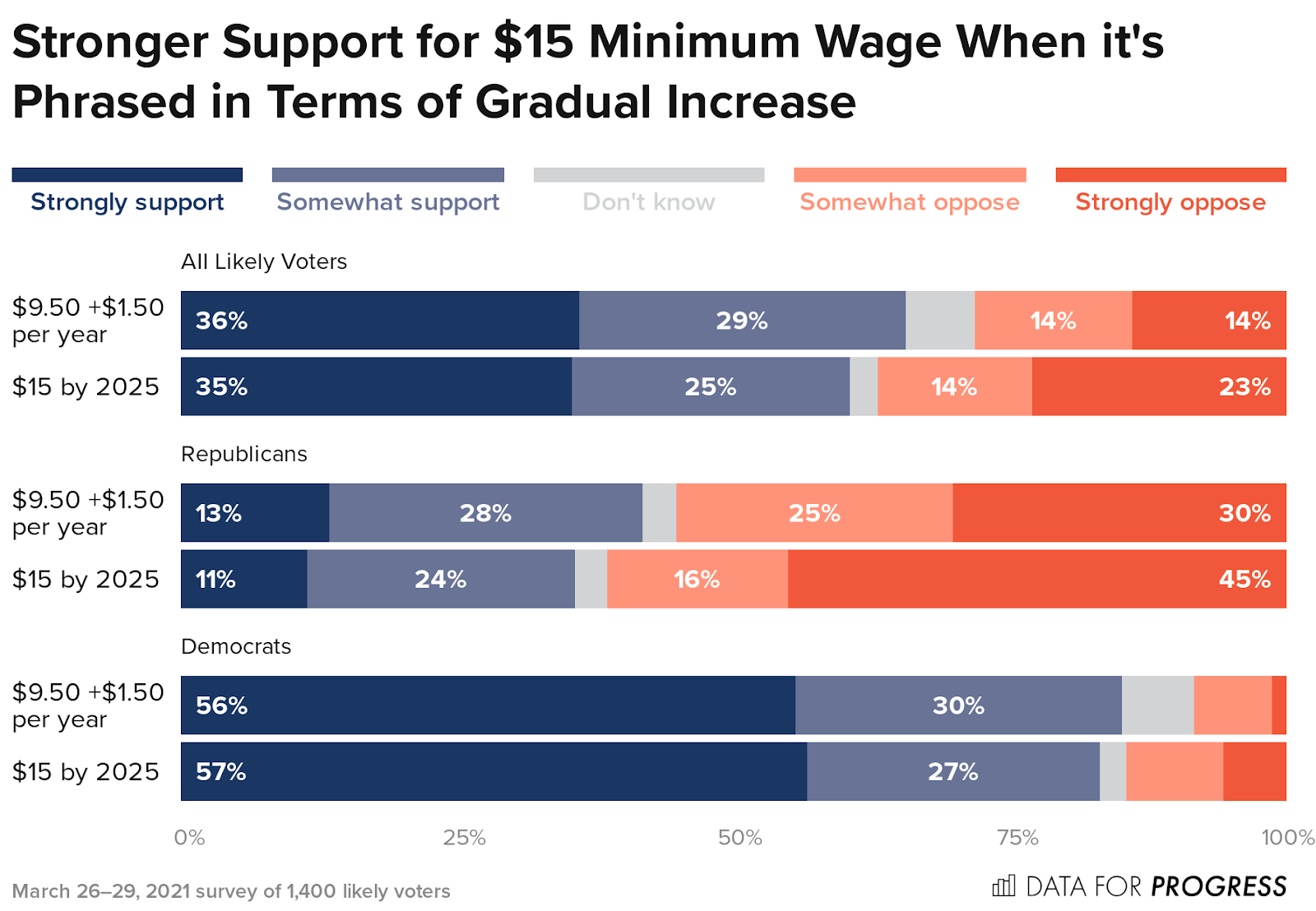Language of Polling Questions Impacts Support For A $15 Minimum Wage
By Charlotte Swasey
Polling questions about the minimum wage perform better when using language similar to the Florida minimum wage ballot measure
Framing the Raise The Wage Act as a $9.50 an hour wage that increases by $1.50 each year, as opposed to simply describing it as raising the minimum wage to $15 an hour by 2025, significantly increases support among Republicans and Democrats
As part of a larger effort to investigate discrepancies between polled issue support and ballot initiative results, we began to dig into the language used to poll support for minimum wage increases.
The simplest possible framing of this question is as follows:
How strongly do you support or oppose a $15 minimum wage?
However, the laws under consideration do not immediately raise the wage to $15 an hour, but rather have a phase-in period, and a specific date at which the $15 number will be hit. This makes them slightly less drastic than the simple framing may suggest. This framing also provides no context about the specific bill under consideration at the federal level, or what the current wage is, as a benchmark.
With that in mind, the next possible framing is:
The current federal minimum wage is $7.25 an hour. The Raise the Wage Act is a proposal to raise it so that minimum wage would be increased to $15 per hour by 2025. Do you support or oppose the Raise the Wage Act?
This gives needed context, and explains to respondents what the particular proposal is. It also specifies that the increase would be gradual.
The most recent real-world example of a success in passing an increase to the minimum wage was in Florida, where voters in the 2020 election overwhelmingly approved a ballot measure to raise the minimum wage to $15 — even though Democrats struggled in the state’s presidential election. The language in that ballot measure turns out to be slightly different from the framing above, with a greater emphasis on the increase over time.
The ballot measure summary as seen by voters on the ballot was as follows:
Raising Florida’s Minimum Wage
Raises minimum wage to $10.00 per hour effective September 30th, 2021. Each September 30th thereafter, minimum wage shall increase by $1.00 per hour until the minimum wage reaches $15.00 per hour on September 30th, 2026. From that point forward, future minimum wage increases shall revert to being adjusted annually for inflation starting September 30th, 2027.
The language from this ballot measure, while clearly effective, isn’t quite ideal for a survey context, where respondents might lack needed context around current wages or the proposal itself. Drawing from the ballot measure language and combining it with the earlier question, we get the following:
The current federal minimum wage is $7.25 an hour. The Raise the Wage Act is a proposal to gradually raise it. The minimum wage would first be increased to $9.50 an hour in 2021. Then, the minimum wage would be increased by $1.50 an hour or less every year through 2025. Do you support or oppose the Raise the Wage Act?
This framing describes the exact same policy proposition as the previous question, with a $15 minimum wage being achieved by 2025, but like the ballot measure, it highlights the gradual increase over time.
In a March 26th to 29th survey of 1400 national likely voters, we tested these final two frames — increasing the minimum wage to $15 by 2025, versus setting the minimum wage to $9.50 this year and increasing it by $1.50 per year — against each other in a split test, where half the sample was shown one and half shown the other.
We find a large increase in net support using the $9.50 + $1.50 per year framework. Both do well, with the straight $15 frame achieving a 23-point margin of support, but the $9.50 + $1.50 frame does significantly better, achieving a 37-point margin. This is driven by a large decrease in the percentage of voters who “strongly oppose” the proposal, as well as greater uncertainty.
The shifts between the two frames can be seen more clearly in the crosstabs by partisanship. Republican opposition to the measure declines from -26 to -14 — a 12-point net improvement — when using the $9.50 frame. Democratic support also increases dramatically, from a 69-point margin to a 78-point margin. This issue is clearly very polarized by partisanship, but the effect of reframing from the $15 end goal to the gradual increase used to get there has a significant effect across party lines.
It seems likely that the success of the Florida ballot measure was aided by the language it used on the ballot. Proponents of these laws should use the gradual increase framework to increase support and defuse opposition messaging about dramatic jumps in worker pay. Pollsters should take note of this case where a “softer” framing of the issue actually matches what was presented to voters, and adjust their language to match (as some have already done).
Charlotte Swasey is the VP of Data and Polling at Data for Progress. Follow her on twitter @charlotteeffect.
Methodology
From March 26 to 29, 2021, Data for Progress conducted a survey of 1,400 likely voters nationally using web panel respondents. The sample was weighted to be representative of likely voters by age, gender, education, race, and voting history. The survey was conducted in English. The margin of error is ±3 percentage points.

